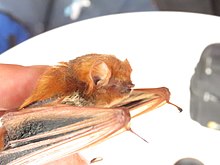| Southern red bat | |
|---|---|

| |
| Scientific classification | |
| Domain: | Eukaryota |
| Kingdom: | Animalia |
| Phylum: | Chordata |
| Class: | Mammalia |
| Order: | Chiroptera |
| Family: | Vespertilionidae |
| Genus: | Lasiurus |
| Species: | L. blossevillii
|
| Binomial name | |
| Lasiurus blossevillii (Lesson and Garnot, 1826)
| |

| |
| Southern red bat range in red | |
The southern red bat (Lasiurus blossevillii)[1] is a species of microbat found in South America.[2]
Taxonomy[edit]
Previously, the western red bat (L. frantzii) was classified as a subspecies of the southern red bat, but phylogenetic evidence supports it being a distinct species. This has been followed by the American Society of Mammalogists and the ITIS.[3][4]
It was named after French explorer Jules de Blosseville.[5]
Distribution[edit]
The species is recorded in Argentina, Bolivia, Brazil, Colombia, Ecuador (Galápagos Islands), French Guiana, Guyana, Paraguay, Peru, Suriname, Trinidad and Tobago, Uruguay and Venezuela.[1]
See also[edit]
- Eastern red bat – Lasiurus borealis
- Western red bat – previously considered a subspecies of Lasiurus blossevillii
- Bats of the United States
References[edit]
- ^ a b c Gonzalez, E.; Barquez, R. & Miller, B. (2016). "Lasiurus blossevillii". IUCN Red List of Threatened Species. 2016: e.T88151055A22120040. doi:10.2305/IUCN.UK.2016-1.RLTS.T88151055A22120040.en. Retrieved 19 November 2021.
- ^ "Lasiurus blossevillii (Lesson & Garnot, 1826)". ASM Mammal Diversity Database. American Society of Mammalogists. Retrieved 9 February 2022.
- ^ "Lasiurus frantzii, (W. Peters, 1870)". ASM Mammal Diversity Database. American Society of Mammalogists. Retrieved 12 September 2020.
- ^ "Lasiurus". Integrated Taxonomic Information System. Retrieved 9 February 2022.
- ^ Bo., Beolens (2009). The eponym dictionary of mammals. Johns Hopkins University Press. ISBN 978-0-8018-9533-3. OCLC 593239356.

Well, that’s interesting to know that Psilotum nudum are known as whisk ferns. Psilotum nudum is the commoner species of the two. While the P. flaccidum is a rare species and is found in the tropical islands. Both the species are usually epiphytic in habit and grow upon tree ferns. These species may also be terrestrial and grow in humus or in the crevices of the rocks.
View the detailed Guide of Psilotum nudum: Detailed Study Of Psilotum Nudum (Whisk Fern), Classification, Anatomy, Reproduction